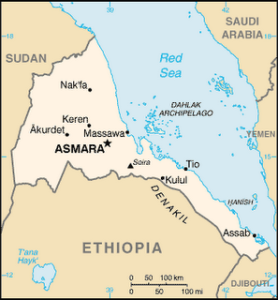- BY Colin Yeo

Refugees and refoulement: the Supreme Court
THANKS FOR READING
Older content is locked

A great deal of time and effort goes into producing the information on Free Movement, become a member of Free Movement to get unlimited access to all articles, and much, much more
TAKE FREE MOVEMENT FURTHER
By becoming a member of Free Movement, you not only support the hard-work that goes into maintaining the website, but get access to premium features;
- Single login for personal use
- FREE downloads of Free Movement ebooks
- Access to all Free Movement blog content
- Access to all our online training materials
- Access to our busy forums
- Downloadable CPD certificates
 In the case of R (on the application of ST (Eritrea)) v Secretary of State for the Home Department [2012] UKSC 12 the Supreme Court has held that it is not unlawful to seek to remove to another country a person who has already been recognised as a refugee in respect of one country. The context here, as might perhaps be guessed from the name of the case, is that the individual concerned has been recognised as a refugee from Eritrea. However, the UK Border Agency decided to try instead to remove her to Ethiopia, where she might have a claim to citizenship.
In the case of R (on the application of ST (Eritrea)) v Secretary of State for the Home Department [2012] UKSC 12 the Supreme Court has held that it is not unlawful to seek to remove to another country a person who has already been recognised as a refugee in respect of one country. The context here, as might perhaps be guessed from the name of the case, is that the individual concerned has been recognised as a refugee from Eritrea. However, the UK Border Agency decided to try instead to remove her to Ethiopia, where she might have a claim to citizenship.
The case arises from the Eritrean-Ethiopian civil war and its aftermath, when both countries took measures to expel or deny rights to those within their territory who were thought to be in some way from or of the other. It is a depressing backcloth. This particular appellant was born in what is now Ethiopia and lived there all her life, before coming to the United Kingdom. Nevertheless, the Home Office decided to remove her to Eritrea and set formal removal directions to that effect. She appealed and was successful in showing that she had a well founded fear of persecution in Eritrea. However, the judge dismissed her appeal on the basis that she could be removed to Ethiopia. This decision was then overturned on appeal because there was no question of her being removed to Ethiopia at that time.
It isn’t terribly hard to imagine what happened next: after the conclusion of the appeal the Home Office, instead of recognising ST as a refugee the Home Office set removal directions to Ethiopia. ST lodged an appeal, which remains pending, and applied by way of judicial review for a mandatory order requiring the Secretary of State to recognise ST as a refugee. ST succeeded in the High Court but that decision was overturned by the Court of Appeal. The case thus proceeded to the Supreme Court.
The Supreme Court judgment is based on the distinction between Articles 32 and 33 of the 1951 UN Convention Relating to the Status of Refugees, usually known as the Refugee Convention.
Article 33(1) is usually thought of as the ‘non refoulement’ provision, which prevents removal either directly or indirectly (hence the use of the French word which connotates both meanings). It reads as follows:
No Contracting State shall expel or return (‘refouler’) a refugee in any manner whatsoever to the frontiers of territories where his life or freedom would be threatened on account of his race, religion, nationality, membership of a particular social group or political opinion.
Article 32(1) provides as follows:
The Contracting States shall not expel a refugee lawfully in their territory save on grounds of national security or public order.
The Court held that it was Article 32(1) that was relevant and that ST was not ‘lawfully’ in the territory of the United Kingdom because she had not been granted leave to enter or remain. The word ‘lawfully’ was construed to mean ‘lawfully under domestic law’, not in a wider sense of having justification under the Refugee Convention or similar. It was therefore permissible for the Home Office to seek to remove ST to Ethiopia notwithstanding that she has been found to be a national of Eritrea and a refugee in respect of Eritrea.
Some might question why the Home Office did not set removal directions ‘in the alternative’ to both Ethiopia and Eritrea in order to permit proper exploration of all the issues in the first place. As I remember, it simply was not possible at that time. For the life of me I cannot remember when or how (any suggestions anyone?), but I’m pretty sure the law has now been amended to allow different destinations to be specified in removal directions.
It might also be asked how the Home Office can seek to remove a person to a country of which he or she is not a national. The power is tucked away at paragraph 8(c) to Schedule 2 of the Immigration Act 1971, which imparts a power to set removal directions to the following:
(i) a country of which he is a national or citizen; or
(ii) a country or territory in which he has obtained a passport or other document of identity; or
(iii) a country or territory in which he embarked for the United Kingdom; or
(iv) a country or territory to which there is reason to believe that he will be admitted.
ST will now need to fight her appeal in respect of Ethiopia. That may look like a tall order given the findings of the original judge and the passage of time since she left the country, but given she has been accepted to be an Eritrean national it is unlikely in the context of the civil war and ongoing rumblings that the Ethiopians will welcome her back with open arms.
SHARE


6 responses
very interesting determination from the UKSC, bound to cause even more confussion amongst advisers and other human rights activists. In such ‘refoulement’ cases of double or more nationalities isnt the defendant compelled to prove to the relevant standard of proof of lack of any future likelihood of persecution for convention reasons in either Countries….on top of the general criteria as may apply under Para 8 sch 2 of the 1971 Act?
“The Court held that it was Article 32(1) that was relevant and that ST was not ‘lawfully’ in the territory of the United Kingdom…”
By an extension of that logic, nobody who is in the UK, or presents to immigration control, or arrives there by any means, would be able to claim asylum without having a visit visa or LTR. Is that a valid argument against what was held in this case?
As for 8c(iii), would it perhaps be viable to seek to obtain a statement from the Ethiopian authorities/embassy that ST would be denied entry or leave to remain there? If so, removal under that point wouldn’t be relevant.
Refugee status is a grant of international protection. If it can be established that an applicant was ‘habitually resident’ in another country then the Convention allows for return (rather than refoulement). Indeed it may be argued that the only right a refugee has is the right of non-refoulement.
International protection is for future protection, when faced with persecution for a protected reason. In cases of double or more citizenship, shd the only question by the Courts be eligibility of admission of the aslyum seeker or its shd go further to asses if the aslyum seeker has any other Convention fears there2! if so, who then carries the burden of proof of such fears, the claimant or the ‘refouling’ state party?……….
(2)is the UK’s interpretation of ‘lawful present’ compatiable with the purposive interpretation of International protection under the Geneva convention, if not shd such questions be purely left to domestic law interpretation which might be at odds with International law and its overiding objectives?…………
The Immigration (Notices) (Amendments) Regulations 2006 (2006/2168) amended the 2003 Notices Regulations so as to allow more than one country to be nominated as the destination.
Many thanks, JJ! GD privately emailed me slightly before you and therefore wins the box of chocolates, though.